Once we made the decision that we wanted to go cruising, we started looking at what kind of boat would be “right” for us. Earlier in my life, I had looked at buying a Catalina 36 or a Catalina 400 Mk II for cruising. In December 2018, we chartered a 40′ monohull in the BVIs. Kelly’s reaction to healing indicated that she was not a monohull sailor. When we returned the charter boat to the Moorings base, we checked out a few of the Leopard catamarans before heading off to the Beef Island airport. The space of the catamaran appealed to Kelly almost as much as the promise of flat sailing. When we returned to the BVIs in December 2019, we chartered a 2019 Leopard 40 and Kelly was sold on the catamaran lifestyle, even though it would delay going cruising because a catamaran requires a larger cruising kitty.
I spent a bunch of time gathering information about different catamarans, looking at the different configurations and eliminating some of them based on certain features. Here are some of the reasons that I eliminated certain catamarans:
- Engines under the aft bunks. I’ve chartered some of those boats and the aft cabins can get warm. In a tropical environment, that’s not such a good thing.
- Having the engines under the bunks normally means a shaft drive rather than a saildrive. Shaft vs Saildrive is another boating holy war. My preference is for the saildrive.
- We didn’t want a boat older than 2010 because we expected to be cruising until 2040 and were concerned with having a 30-year old boat then. Eliminating older boats resolved most of the sail drive versus shaft drive issues and nearly all of the “engine under the bunk” issues.
- Since I hope that we will eventually do some longer blue water passages, the idea of having the helm on the aft quarter, like Gemini and Nautitech, didn’t make me feel safe. I realize that the majority of time that you’re on a passage, you’re not at the helm but I worry about a storm where the auto-pilot is dead and someone needs to be out there.
- I really liked the Bali’s garage door thing that extends the salon into the cockpit but I don’t consider a cat with a fully enclosed bow (ie no trampoline) to be blue water safe. I know people take Balis around the world. I just wouldn’t do that. Having a solid foredeck means more water on the nose. Likewise, the forward cockpits of the Leopard 44 didn’t strike me as a good thing if caught in a storm.
- I didn’t explicitly eliminate boats with dagger boards but as we worked the list down to the “big three” catamaran manufacturers, dagger boards were eliminated.
- I didn’t like the boats that have the “escape hatches” in the hulls because that’s two really big holes in the bottom of the boat… oh, yeah and they leak. Not fun.
- We eliminated some of the pricey models like Gunboats, Outremer and SunReef because, well, there’s no way we could afford that.
What we knew we wanted in a boat was an easier list:
- We were looking for a catamaran in the 39 to 42 foot range that was three or four cabin, two heads and galley up.
- We wanted a boat that could carry a diverse set of sails: main + jib, two headsails, a symmetrical spinnaker, a gennaker/asym-spin, a code zero. The point being to cover both heavy wind and (the more expected) light wind sailing situations.
- We really wanted an “owner’s version” with one dedicated hull to the master suite.
- One of the desires was to have a boat with a mast height that’s compatible with the east coast ICW…. At least to the Julia Tuttle Bridge.
- The heads needed to have a separate shower stall. I wanted showering over a toilet to be a thing of the past.
- A boat with dinghy davits was pretty easy since we were looking at catamarans.
- We wanted a cat with a hard bimini and we wanted to be able to add a solar arch.
- We liked the “raised helm” concept but a boat like the older Leopard 43 or Lagoon 380 was not a deal breaker.
After looking online at a very large number of different boats and manufacturers, we ended up principally looking at the big three: Lagoon, Fountaine Pajot and Leopard. We made this choice because there were more of them available on the market, we could easily charter them for a “test drive”, most of their boats passed our “exclusion” list and since there are far more of them out there, the users groups are larger. Maybe it would be easier to get parts. Maybe. After categorizing the three, we liked the Leopard 40, FP Lucia 40, FP Isla 40, Lagoon 39 and Lagoon 40.
We went to the 2022 Miami Boat Show specifically to get on most of these boats and have a look around.
Leopard 40
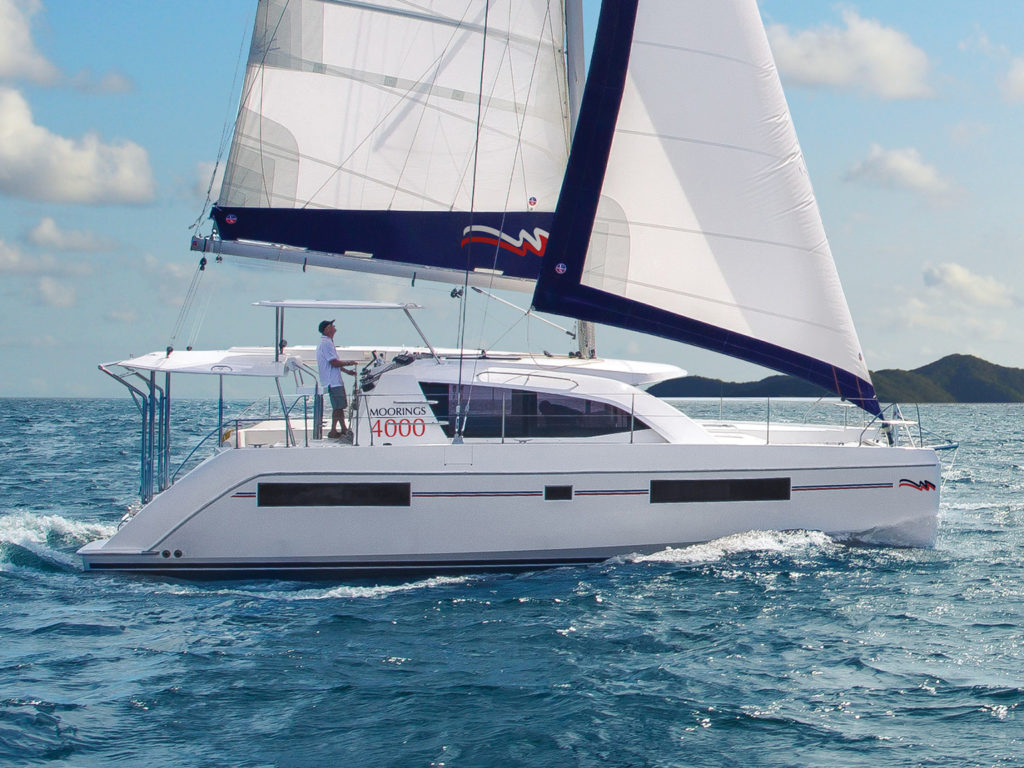
We’ve actually chartered the Leopard 40. We liked the layout of the galley forward. Access to the foredeck is through a door in the salon. If we were willing to accept a used charter boat, there are plenty of Leopard 40s for sale, both the 4-cabin and 3-cabin versions. The L40 has sail drives, standup showers (or a house-sized shower stall in the case of the owner’s version). The port forward cabin can easily be converted to a workshop. I was getting very close to committing to the Leopard 40 as a new boat purchase when I learned that it was being replaced by the Leopard 42, which I discuss below. This boat is probably still our first choice.
Fountaine Pajot Isla 40
We were on the Isla 40 at the Miami Boat Show. We very much liked the layout. Even the price for a new model was “possible” for us. The appeal of picking up the boat either in the Med or at La Rochelle is exciting. If we were to buy a new boat, it would probably be an Isla 40. Kelly is the holdout here. She really liked the front door on the Leopard 40.
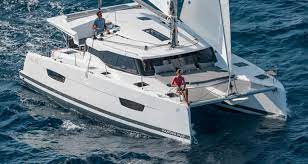
Fountaine Pajot Lucia 40
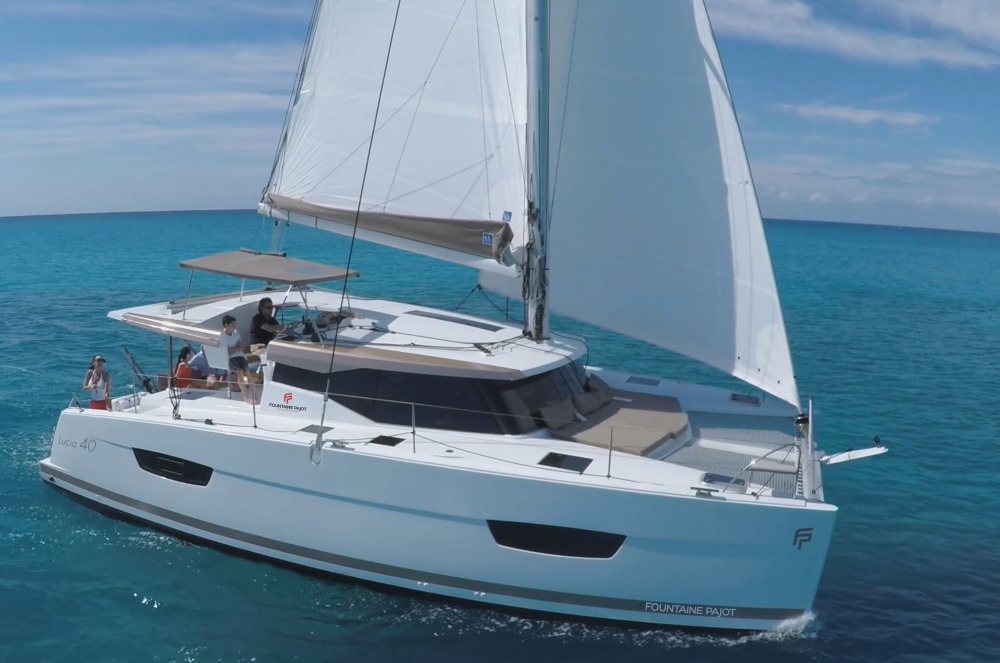
We’ve never been on a Lucia 40 but it is similar to the Isla 40, which we have been on. Our next charter will probably be on a Lucia or Isla 40.
Leopard 39
The Leopard 39 is our fallback. It’s similar to the Leopard 40 but without the front door. It’s the previous design generation, having the galley aft in the salon. The galley is U-shaped, as opposed to the L-shape of the Leopard 40. If we don’t charter an FP Lucia or Isla next, it will be a Leopard 39.
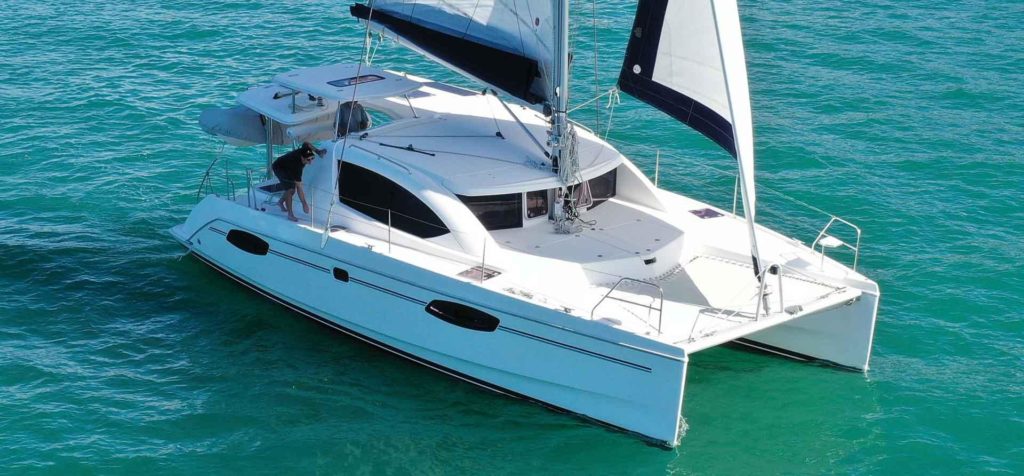
Lagoon 40
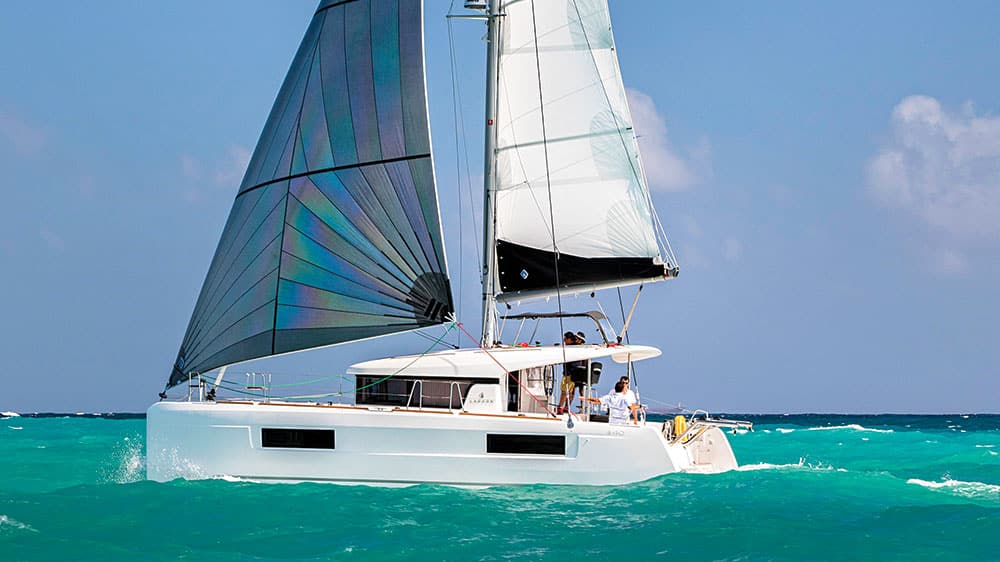
We looked at the Lagoon 40 at the Miami Boat Show. The things that I don’t like about the Lagoon family is thinness of the trampoline (replaceable) and the anchor chain track that runs across the trampoline (not so replaceable). The thinner tramp actually is better for blue water as water would drain through it faster than the tramp on a Leopard. We were both put off with the interior of the Lagoon 40, particularly in the salon and galley.
Lagoon 39
We were able to get on a Lagoon 39 at the Miami Boat Show. The 39 is the “oldest” of the boats that we’re considering having been first produced in 2013. Same as with the Lagoon 40, neither of us really liked the layout of the salon and galley in the Lagoon 39s.
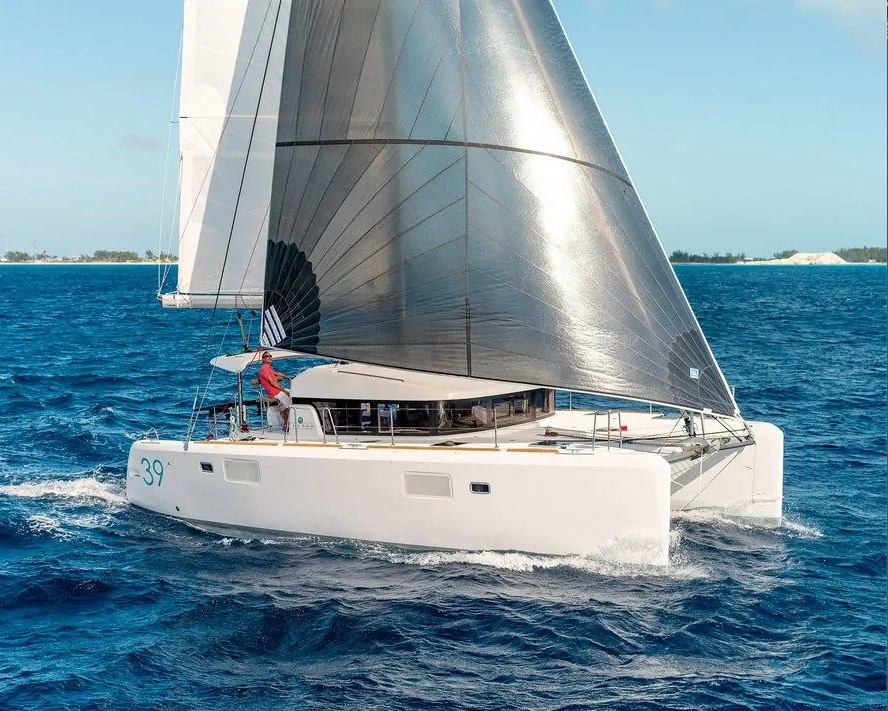
Leopard 42
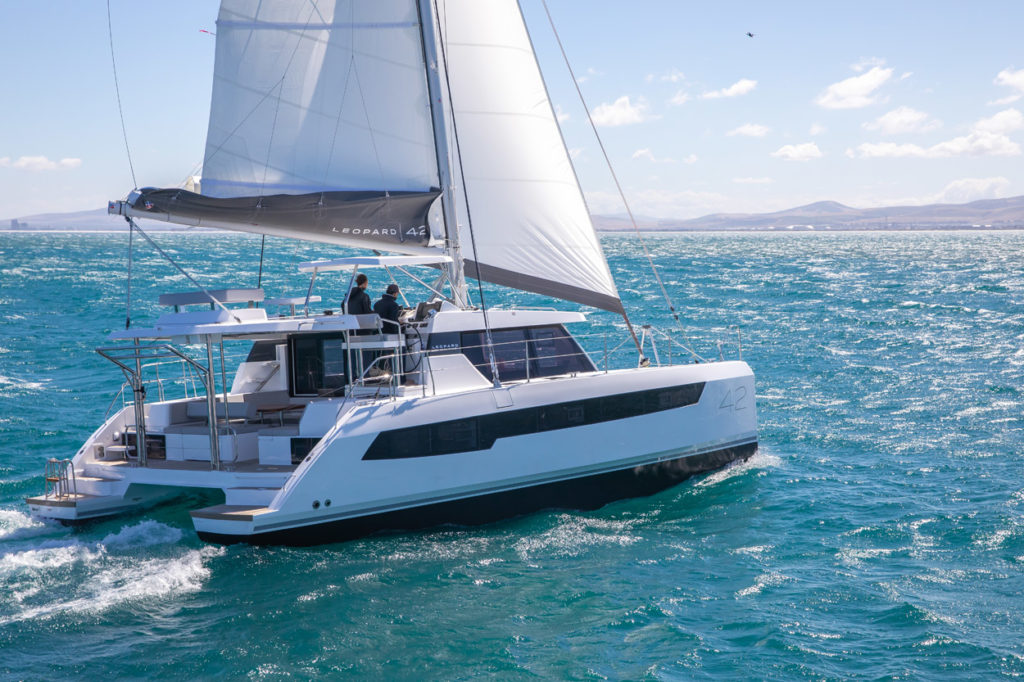
The Leopard 42 had just replaced the Leopard 40 as the smallest boat offered by Leopard. We excluded the Leopard 42 from our potential list as the top of the hard bimini now has a lounge. There isn’t an option to order the boat without the lounge (I asked; The Leopard rep in Miami looked at me like I had three heads). Moorings is huge Leopard customer and the L42 is clearly targeting the charter market. Not that it isn’t a blue water boat but I’d rather use the top of my bimini for solar panels and be able to reach my boom without a ladder.
Lagoon vs Leopard vs Fountaine Pajot
Here are my findings when comparing the above boats:
- The mast height on all of them is ICW-friendly, with the Lagoon 39 and 40 being the shortest. The Leopard 40 has the pucker-factor of a 63’10” mast.
- The Leopards have the larger water tank capacity at 206 gallons, the Lagoon 40 has 80 gallons, FPs have 140 and the Lagoon 39 has 159.
- Fuel capacity for all of these boats is around 100 gallons.
- The Leopard 40 and the FPs have 30hp engines with the Lagoon 39 and 40 having an upgrade option to 40hp and 45hp respectively. That’s Yanmars on the Leopards and Lagoons, and Volvos on the FPs.
- All the boats have a beam of about 22′ and a bit, except the Lucia 40 at 21’10”.
- The Lagoons displace the most at just over 24000 where the FPs and Lepoards are all under 21000, which is under 10 metric tonnes.
- I’ve found limited information on the hull constructions type below the waterline. I believe the Lagoon 40 is solid fiberglass from the waterline down. I’ve also read that with foam core, assuming closed cell foam constructed in the last 10 years — which these boats all are, there is less risk of things getting soggy inside. Not sure how true this is, though.
- The Lagoons carry the anchor on the crossbar where as the FP and Leopards carry the anchor near the nacelle.
